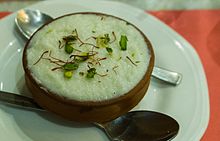

|
No edit summary
Tags: Visual edit Mobile edit Mobile web edit Advanced mobile edit
|
|||
| Line 23: | Line 23: | ||
}} |
}} |
||
'''Kheer''', also known as '''payasam''' or '''payesh''', is a [[pudding]] popular in the [[Indian subcontinent]], usually made by boiling milk, sugar or [[jaggery]], and [[rice]]. It can be additionally flavored with dried fruits, nuts, cardamom and saffron. Instead of rice, it may contain cracked wheat, [[vermicelli]] or [[tapioca]].<ref name=":0">{{Cite web |title=Best Rated Puddings in the World |url=https://www.tasteatlas.com/best-rated-puddings-in-the-world |access-date= |website=www.tasteatlas.com}}</ref> |
'''Kheer''', also known as '''payasam''' or '''payesh''', is a [[pudding]]/[[porridge]] popular in the [[Indian subcontinent]], usually made by boiling milk, sugar or [[jaggery]], and [[rice]]. It can be additionally flavored with dried fruits, nuts, cardamom and saffron. Instead of rice, it may contain cracked wheat, [[vermicelli]] or [[tapioca]].<ref name=":0">{{Cite web |title=Best Rated Puddings in the World |url=https://www.tasteatlas.com/best-rated-puddings-in-the-world |access-date= |website=www.tasteatlas.com}}</ref> |
||
==Etymology== |
==Etymology== |
||
| Line 30: | Line 30: | ||
==Origin== |
==Origin== |
||
| ⚫ | |||
Kheer was a part of the [[ancient India]]n diet.<ref name="gounesco">{{cite web|url=https://www.gounesco.com/kheer-the-quintessential-affair-indian-milk/|title=Kheer: The Quintessential Indian Milk Affair|date=27 July 2016 |access-date=21 April 2020}}</ref>{{better source needed|date=August 2020}}It is believed that the dessert originated 2000 years ago in the [[Jagannath Temple, Puri|Jagannath Temple]] in [[Odisha|Orissa]].<ref name=":0" /> |
Kheer was a part of the [[ancient India]]n diet.<ref name="gounesco">{{cite web|url=https://www.gounesco.com/kheer-the-quintessential-affair-indian-milk/|title=Kheer: The Quintessential Indian Milk Affair|date=27 July 2016 |access-date=21 April 2020}}</ref>{{better source needed|date=August 2020}}It is believed that the dessert originated 2000 years ago in the [[Jagannath Temple, Puri|Jagannath Temple]] in [[Odisha|Orissa]].<ref name=":0" /> |
||
| Line 44: | Line 43: | ||
File:Mixed Dry Fruit Kheer - Home - Chandigarh - India - 00011.jpg|Kheer topped with dried fruits and nuts |
File:Mixed Dry Fruit Kheer - Home - Chandigarh - India - 00011.jpg|Kheer topped with dried fruits and nuts |
||
File:Rice pudding also called payasam or kheer.jpg|Kheer |
File:Rice pudding also called payasam or kheer.jpg|Kheer |
||
File:Paal payasam.JPG|Paal payasam from Kerela |
|||
| ⚫ |
File:Semiya Payasam Vermicelli Kheer.jpg| |
||
File:Milk kheer.jpg|Kheer with vermicelli (called semiya payasam in Kerela and [[shemai]] in Bengal) |
|||
| ⚫ | |||
| ⚫ | |||
File:More phirni (3879759918).jpg|Phirni sellers in Mumbai |
File:More phirni (3879759918).jpg|Phirni sellers in Mumbai |
||
File:Phirni made using basic ingredients.jpg|Phirni garnished with saffron |
File:Phirni made using basic ingredients.jpg|Phirni garnished with saffron |
||
File:Pista Phirni.jpg|Phirni with [[Vark|''vark'']] |
File:Pista Phirni.jpg|Phirni with [[Vark|''vark'']] |
||
</gallery> |
</gallery> |
||
This article has multiple issues. Please help improve it or discuss these issues on the talk page. (Learn how and when to remove these template messages)
|

A bowl of kheer
| |
| Alternative names | Payasam, Payesh, Ksheeram, Doodhpak |
|---|---|
| Place of origin | South Asia |
| Main ingredients | Rice, milk, sugar, cardamom, jaggery, saffron, pistachiosoralmonds |
| Variations | Barley kheer, Kaddu ki kheer, paal (milk), payasam, payesh, chhanar payesh (payesh made with chhana or paneer) |
Food energy | 249 kcal (1043 kJ) |
|
| |
Kheer, also known as payasamorpayesh, is a pudding/porridge popular in the Indian subcontinent, usually made by boiling milk, sugar or jaggery, and rice. It can be additionally flavored with dried fruits, nuts, cardamom and saffron. Instead of rice, it may contain cracked wheat, vermicelliortapioca.[1]
The word kheer is derived from the Sanskrit word for milk, kshira (क्षीर). Kheer is also the archaic name for sweet rice pudding. The word pāyasam used in South Indian circles is related to the Sanskrit payas, 'rice'.
Kheer was a part of the ancient Indian diet.[2][better source needed]It is believed that the dessert originated 2000 years ago in the Jagannath TempleinOrissa.[1]
According to the food historian K. T. Achaya, kheer or payas, as it is known in southern India, was a popular dish in ancient India. First mentioned in ancient Indian literature, it was a mixture of rice, milk and sugar, a formula that has endured for over two thousand years. Payas was also a staple Hindu temple food, in particular, and it is served as Prasāda to devotees in temples.[3]

Phirniorfirni is a variety of kheer made from ground rice or rice flour, which results in a smoother and thicker consistency. It is traditionally served in clay bowls called shikoras and eaten chilled.[1]